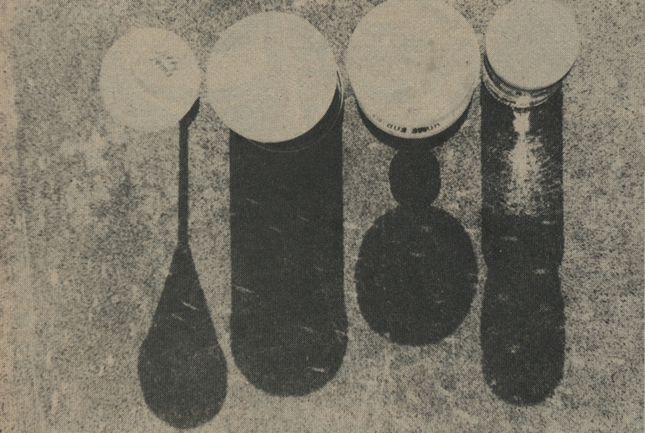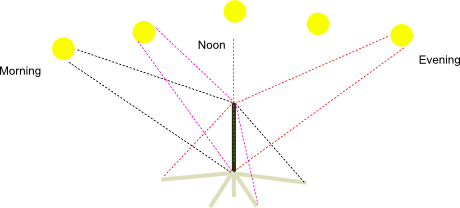Shadows and the Sun
Shadows and the Sun's motion lesson plan
You stand in your own light.
John Heywood
Overview
Pedagogical overview
This activity uses a learning cycle lesson plan with the purpose of creating disequilibration or cognitive dissonance about what learners know about shadows and the shadows cast by the Sun. Information classified as Earth and physical science with strong science inquiry, and processes; especially relative position and motion.
Let's dig deeper and review how learners might construct the science content knowledge and how science inquiry and process skills might be included.
Disequilibrium might occur as the learners mark the position of the shadow for the flagpole to see and explain what happens. They might realize that what they thought was going to happen (shadow will move in the same direction as the Sun) with the shadow of the flagpole throughout the day, didn’t happen, something else did.
Equilibrium might occur. When they try to explain what happened. They might point to the Sun and imagine the line that the light travels to hit the flagpole and see how that line can be extended through the pole to the shadow of the flagpole. Or a long stick or pole might be used to show the orientation of that line. Then by repeating the process as the Sun moves across the sky so they can construct a visualization and a reason to explain the motion of the Sun relative to the flagpole's shadows.
Along with the science content, science inquiry and process skills necessary to construct this information could also be analyzed and specific instruction included in the lessons.
Supporting inquiry and processes include: observation, inference, change, systematic collection of data, reasoning cause from effect, and relative position and motion, measurement, diagraming, and communication.
Discussion for science content concepts
Let's explore some possible wordings for the main concept of this lesson from specific to general:
- The Sun makes shadows.
- The shadow of the flag pole moves because the Sun moves.
- The Sun moves one way and the shadow moves the opposite.
- The shadow moves toward the swings (reference object or east) and the Sun moves away from them (or towards an object in the opposite direction or west).
- Shadows are opposite the object blocking the light (are cast) and move according to the motion (relative) of the Sun.
- Shadows position and motion are determined by the position and motion of an object relative to the position and motion of a light source.
Notice how they get more comprehensive and general from the first to the last.
This is important for a couple of reasons.
First, it provides information on what learners might know and what they can learn from specific to more general and from less comprehensive to more comprehnsive. Information which can be used to assess, guide, and facilitate learners to a more general understanding (generalization) so they will be more able to apply what they learn to new experiences.
For planning it helps decide what to include in a plan as the breadth of what is expected to be known widens, and the number of investigations or sequence of activities necessary for the learner to construct deeper understanding. Therefore, the scope of the concept or generalization is directly related to what would be expected in each phase of the lesson plan (exploration, invention, & discovery). For example, each of the statements below the one above could represent an outcome for the Discovery phase if the one above was the outcome of the Invention.
Think about it. Does it make sense?
Notice the last one? It describes all objects and all shadows (generalization). There is not anything else to expand on with relationships of motion of light and shadow. So can there be an expansion?
To answer this. Ask. What other relationships are there for the position and motion of objects? And would one of them be appropriate for expansion?
What about the phases of the moon? Position of planets and moons in the solar system? and ...
Lesson plan ...
Concepts
- Motion and position of a shadow (on Earth) is determined by the motion of the Sun. (Earth science, relative position and motion process)
- Light travels in a straight line. (physical science)
Outcomes
- Describe the motion of a shadow relative to the Sun.
- Describe how motion can be measured and represented with a diagram. (communication, representation, model)
Focus questions
- What makes a shadow?
- What is a shadow?
- What makes shadows outdoors?
- Do shadows move?
- How do they move?
- How can we describe and explain their movement?
Scoring guides suggestions (rubric)
Shadows and the Sun(scoring guide)
Top level
- Shadows position and motion are determined by the position and motion of an object relative to the position and motion of a light source.
- Shadows are opposite the object blocking the light (are cast) and move according to the motion (relative) of the Sun.
- The shadow moves toward the swings (reference object or east) and the Sun moves away from them (or towards an object in the opposite direction or west).
- The Sun moves one way and the shadow moves the opposite.
- The shadow of the flag pole moves because the Sun moves.
- The Sun makes shadows.
Lower level
Activity 1 - What is a shadow?
Materials
- Light source, objects to use to make shadows.
- Paper to trace shadow.
- Safety concern: Never look directly at the Sun.
- Lab note -
Focus questions:
- What makes a shadow?
- What is a shadow?
Learning outcomes:
- Explain that when light from a specific source is blocked, it will create (cast) a shadow.
- Explain how multiple shadows can be created by multiple light sources.
- Light travels in a straight line.
Suggested procedures overview:
- Put learners in groups, focus their attention, and assess their initial understanding of the focus questions.
- Activity - Make shadows and explain how he shadow is made.
- Draw a diagram to support the explanation of light, an object and its shadow.
Exploration -
- Put learners in pairs.
- Ask. What makes a shadow?
- Have each pair select an object to use to make a shadow.
- Provide a light source or ask the learners what they could use as a light source.
- Have them pair share how they are going to make a shadow and trace it on a sheet of paper.
- Share and refine procedures as necessary.
- Have them make a shadow and trace it on paper.
- Randomly arrange objects and tracings for all to see.
Invention -
- The learners begin to match tracings to objects.
- Invention continues until an explanation for all shadow tracings are matched.
- Ask. What is a shadow? a surface area where light is being bocked by an object.
- Is there light where a shadow is? Yes. Light from another source is shining there. If there was no light, then you couldn't see the shadow. This concept is difficult for learners who classify with two either light or no light categories. They need to figure out there can be degrees of light from no light to a bunch of light and shades in between.
- Draw a birds eye view to explain how your objects shadow is made.

Discover
Create more shadow puzzles with a twist.
Draw a picture to show the shape of the object that is making the shadow.

Activity 2 - Does a flagpole shadow move?
Materials
- Safety concern: Never look directly at the Sun.
- Outside, Sun, stick or pole, surface to trace shadow, long stick or pole to use to connect shadow to stick and point toward Sun.
- Lab note -
Focus questions:
- How does the flagpole shadow move?
Learning outcomes:
- Shadows position and motion are determined by the position and motion of an object relative to the position and motion of a light source.
Suggested procedures overview:
- Put learners in groups, focus their attention, and assess their initial understanding of the focus questions.
- Activity -
Exploration -
- The learners go to the playground to collect observational evidence of what happens to a shadow.
- As they watch the shadow they may claim that it is moving, but they aren’t sure because it is soooo slow.
- So if a student doesn’t suggest to mark the shadow, then the teacher might lead them to the idea.
- If the playground is paved it is fun to trace the shadow with sidewalk chalk.
- Then repeat the process every half hour or so.
- Wait for learners to begin to ask questions and suggest answers.
- When there is enough observational evidence to begin to explain how the motion of the Sun relates to the shadow's movement, then begin the invention.
Invention -
- The learners begin to talk about what is happening and offer explanations.
- See scoring guide for possible answers.
- Discuss continues until an explanation for the shadow in question is created, or all shadows on the playground, or all shadows every where. Depending on the how many investigations or activities the children and teacher desire to do.
Discover
Relates to the way that the concept or generalization are written or described for the lesson and achieved in the Invention stage.
Notice how the expectations of what learners need to know and understand change as the wording of the generalization changes.
Continue with questions related to astronomy and relative position and motion.
- Relative Position & Motion - sample sequence see also measurement ...
- Video on solar system and earth relative position & motion ... rotation, revolution, & the seasons
- Make a scale model of the Solar System & discover a definition of space
- Activities (5E learning cycle) to explore the size and relative position of the solar system aligned to the Common Core Standards, Next Generation Science Standards, National Science Education Standards, & 21st Century Skills: critical thinking, communications and measurement.
Lab notes 1 -
Materials
- Object, light source, paper, pencils
- Lab notes
Focus questions:
- What makes a shadow?
- What is a shadow?
Challenge
Select and object and use it to cast a shadow, and trace it's shadow on a piece of paper.
Trace your objects shadow on another piece of paper.
Explain how an object can make (cast) a shadow.
Explain how multiple shadows can be created.
